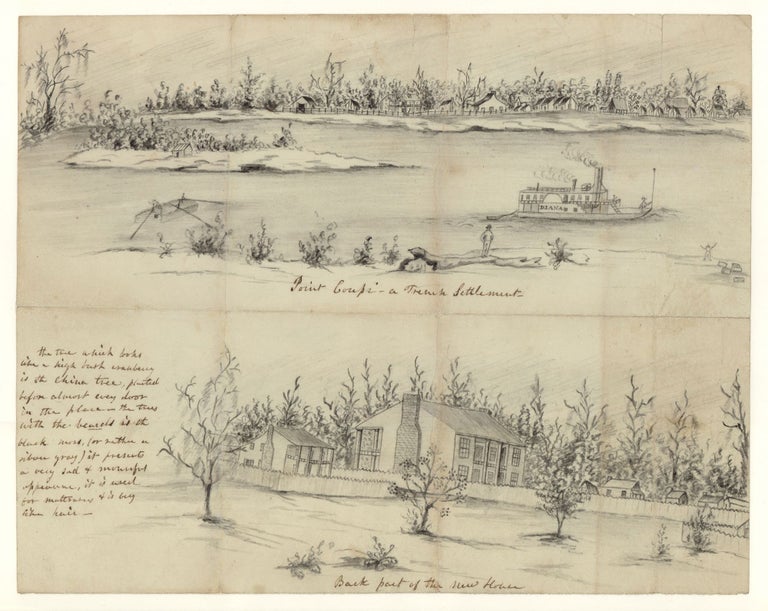Point Coupé—A French Settlement. Back Part of the New House.
Point Coupé, Louisiana, [ca. 1855]. 2 pencil drawings on a single sheet of wove paper, 7.75” x 9.6”, captioned in ink. Two mid-nineteenth century eye-witness drawings of Point Coupeé, one of the oldest settlements in the Mississippi River Valley, executed by a visitor to the region and apparently sent with a letter, likely in the 1850s. Point Coupeé (here spelled Coupé) was first discovered by the French-Canadian brothers Pierre and Jean Baptiste Le Moyne in 1699. The area was first occupied by wayfaring French-Canadian trappers around 1708 and during the 1720s became a permanent settlement of French-Canadian colonists. The name Point Coupeé comes from the French phrase la pointe coupée—‘cut point’ or ‘the cut-off point’—which refers to a former bend in the Mississippi, left behind when the river changed course. Here river travelers would find themselves cut off and had to make their way back to where they originally entered. The upper drawing depicts the settlement of Point Coupeé from the opposite side of the bend, consisting of a plantation home and other dwellings, the smallest of which were likely slave quarters. On the shore in the foreground several men are shown watching the steamboat Diana pass by, which is towing a dinghy. One man, on the lower-right, stands near some parcels on the shore holding his arms up as the steamboat approaches. A flatboat navigated by three figures with characteristically long paddles appears in the waters to the left of the steamboat. The Diana was active on the Mississippi in the 1850s; Currier & Ives published a lithograph in 1859 after a painting by George Fuller depicting an 1858 race between the Diana and the Baltic. The lower drawing depicts the “back part of the new house,” a two-story, fenced-in plantation house, likely the same as that visible in the upper view. A number of lesser buildings, including slave quarters, can be seen nearby, and the artist has given some attention to several trees in the foreground. A note adjacent to the house reads in full: “The tree which looks like a high bush cranberry is the China tree, planted before almost every door in the place. The trees with the beards is the black moss (or rather a ribon gray) it presents a very sad & mournful appearance, it is used for mattresses, & is very like hair.” The Spanish moss common to the region can be seen hanging from many of the trees. Prior to his establishment of New Orleans in 1718 Jean-Baptiste Bienville (1680–1767) established a military post at Point Coupeé. Louisiana’s first public schools were also created in Pointe Coupeé in 1808—the parish being home to Julien Poydras who is regarded as the father of education in Louisiana. Embracing a total of 1,529 sq. km of land and water, Pointe Coupeé was incorporated in 1812 as the twelfth parish of the Territory of Orleans. In 1795, when Point Coupeé was part of New Spain, colonists quashed a premeditated slave insurrection there. Taking their cue from the French and Haitian revolutions, a number of slaves, as well as a few free blacks and white men, planned to set fire to a shed on the Julien Poydras estate and ambush the white men who came to put it out, following which they would spread the revolt from plantaton to plantation. The incident became known as the Pointe Coupée Conspiracy. These plans were discovered before they were carried out, and fifty-seven slaves, including three local white men, were put on trial (in one slave cabin planters found a copy of Theorie de l’impot by Michel Bouvier—a book containing the 1789 Declaration of the Rights of Man.) The trial ended with the hanging of twenty-three slaves, following which their decapitated heads were mounted on posts along the Mississippi. The other thirty-one slaves were sentenced to flogging and hard labor in other Spanish colonies, while the three white men were deported. A rare set of drawings depicting this historic Louisiana settlement. REFERENCES: Pointe Coupee Parish at genealogytrails.com; Welcome to Pointe Coupee at lsuagcenter.com; Louisiana Slave Conspiracies : Point Coupée, Louisiana, 1795 at lsc.berkeley.edu CONDITION: Good, old folds, expert paper pulp repairs to separation at folds, reinforced with Japanese tissue on verso.
Item #5599
Sold


